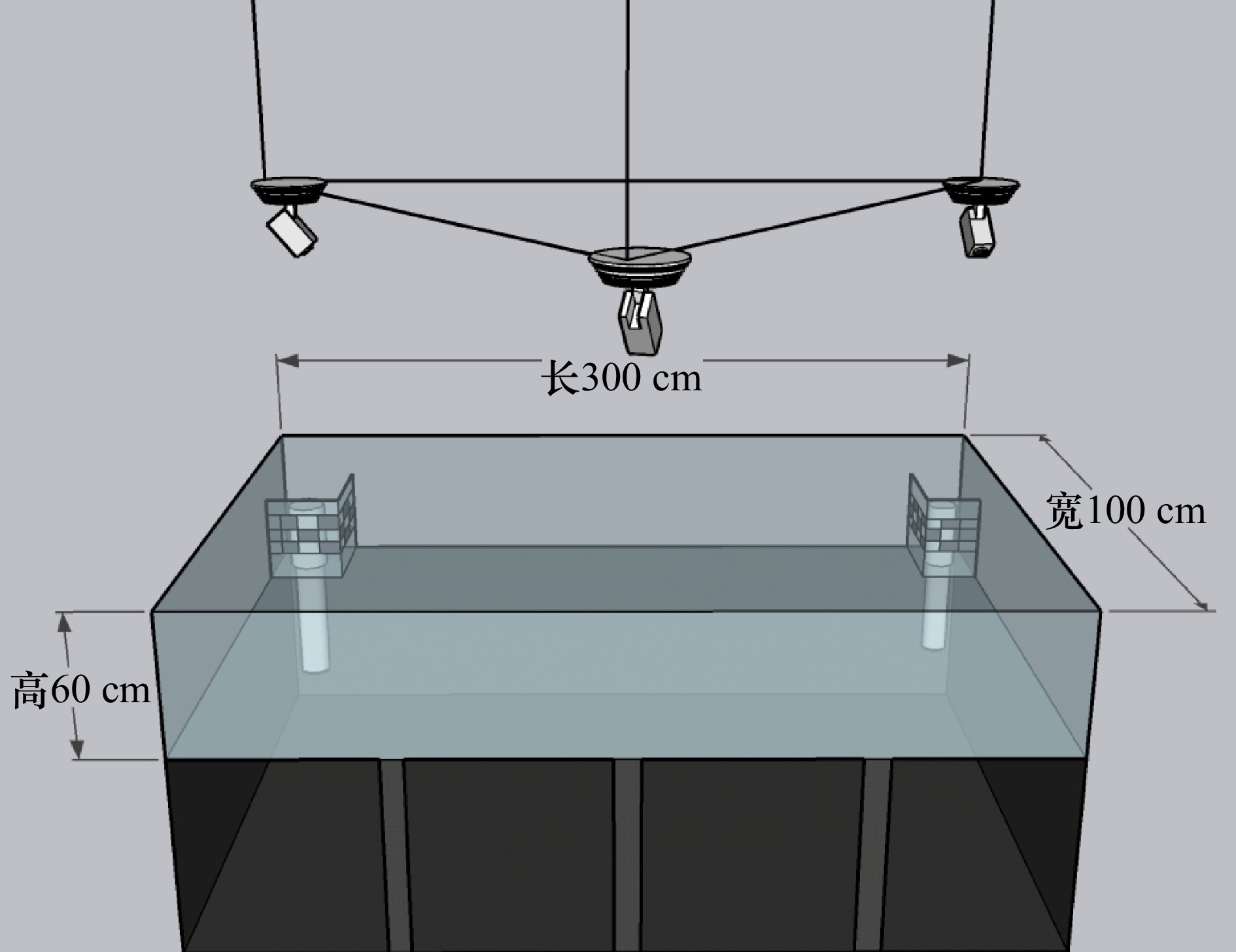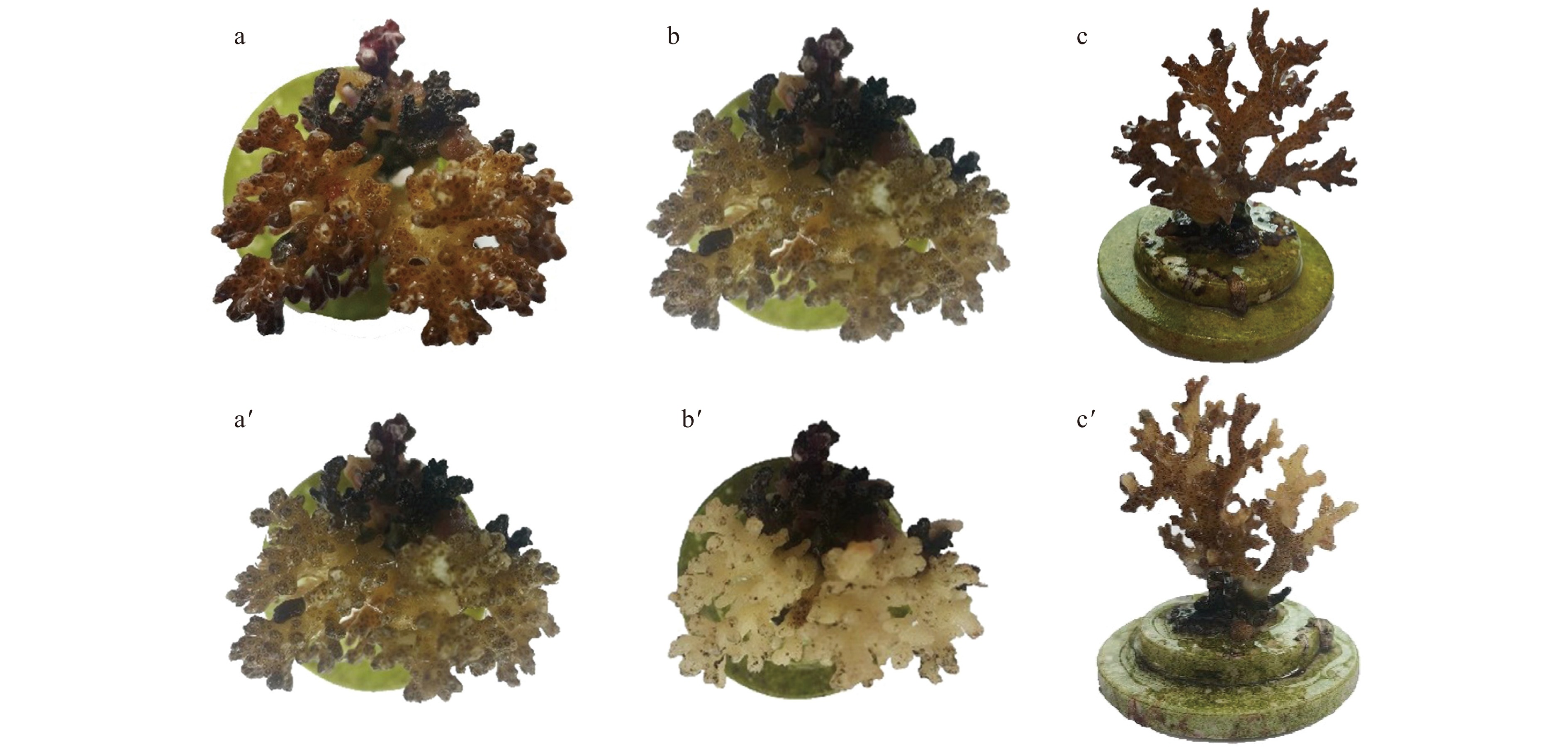Olfactory receptors mediate feeding of Pocillopora damicornis in Crown-of-thorns starfish
-
摘要: 为探究太阳长棘海星(Acanthaster cf. solaris)对鹿角杯形珊瑚(Pocillopora damicornis)的摄食作用及其分子调控机制,本研究以南海典型的鹿角杯形珊瑚为研究对象,结合行为学实验、转录组测序及胃组织酶活性测定,系统分析了嗅觉受体在其摄食行为中的作用。结果表明,太阳长棘海星在摄食鹿角杯形珊瑚后,化学感受器的基因表达发生显著变化,其中89个基因的表达发生显著上调,335个基因发生显著下调。深入挖掘表达上调基因,发现gamma-aminobutyric acid type B receptor subunit 1-like,olfactory receptor 13-like等5个转录组提示的嗅觉受体基因可能在海星识别和摄食鹿角杯形珊瑚过程中发挥了关键作用。同时,摄食行为显著激活胃组织中纤维素酶活性(p < 0.05),而磷酸烯醇式丙酮酸羧化酶和脂肪酶活性也呈增大趋势但未达显著水平,表明纤维素酶可能通过增强对珊瑚和虫黄藻细胞壁的分解能力参与消化过程。本研究初步揭示了太阳长棘海星关键嗅觉受体对摄食行为的介导机制,为深入解析其种群暴发机理提供了重要科学参考。Abstract: To investigate the feeding effects of Acanthaster cf. solaris on Pocillopora damicornis and its molecular regulatory mechanisms, this study focused on the typical P. damicornis in the South China Sea, combining behavioral experiments, transcriptome sequencing, and enzyme activity assays of stomach tissue to systematically analyze the role of olfactory receptors in the feeding behavior of A. cf. solaris. The results showed that the expression of chemical receptor genes in the A. cf. solaris significantly changed during the feeding process on P. damicornis, with 89 genes being significantly upregulated and 335 genes being significantly downregulated. Further exploration of the upregulated genes revealed that five olfactory receptor genes suggested by the transcriptome, including gamma-aminobutyric acid type B receptor subunit 1-like and olfactory receptor 13-like, may play crucial roles in the recognition and feeding on P. damicornis. Meanwhile, feeding behavior significantly activated cellulase activity in the stomach tissues (p < 0.05), whereas the activities of phosphoenolpyruvate carboxykinase and lipase showed an increasing trend but did not reach statistical significance. This suggests that cellulase may be involved in the digestive process by enhancing the degradation of coral skeletons and zooxanthella cell walls. This study provides preliminary insights into the mediation of feeding behavior by key olfactory receptors in Acanthaster cf. solaris and offers important scientific references for further understanding the mechanisms behind population outbreaks.
-
图 3 鹿角杯形珊瑚被太阳长棘海星摄食前后的状态
a、b和c为珊瑚被摄食前的状态,a′、b′和c′分别为a、b和c中珊瑚被太阳长棘海星摄食后的状态
Fig. 3 Pocillopora damicornis before and after being ingested by Acanthaster cf. solaris
a, b and c indicate Pocillopora damicornis before being ingested, and a′, b′ and c′ indicate Pocillopora damicornis after being ingested by Acanthaster cf. solaris, correspondingly
表 1 太阳长棘海星对鹿角杯形珊瑚的摄食时长
Tab. 1 Duration of feeding by Acanthaster cf. solaris on Pocillopora damicornis
时间 第1只 第2只 第3只 开始摄食时间 02:50 00:32 01:19 结束摄食时间 07:22 05:06 06:27 总摄食时间 4h32min 4h34min 5h8min 表 2 对照组与处理组太阳长棘海星样品的序列数和基因组比对率
Tab. 2 The sequence number and gene alignment rates of Acanthaster cf. solaris transcriptome libraries in the control group and treatment group
组别 序列数 比对率/% 处理组1 36 205 074 90.79 处理组2 36 156 637 89.94 处理组3 36 211 819 90.27 对照组1 36 160 729 89.65 对照组2 36 062 532 88.97 对照组3 36 122 387 90.63 表 3 介导太阳长棘海星摄食鹿角杯形珊瑚的潜在嗅觉受体
Tab. 3 Potential olfactory receptors mediating the feeding behavior of Acanthaster cf. solaris on Pocillopora damicornis
NCBI号 CDS长度 所编码氨基酸 结构域 变化倍数(处理组/对照组) XP_022093142.1 2421 bpgamma-aminobutyric acid type B receptor subunit 1-like ANF结构域、7tm_3结构域 2.84 XP_022085751.1 1128 bpolfactory receptor 13-like 7tm_1结构域 12.65 XP_022105908.1 2346 bpgamma-aminobutyric acid type B receptor subunit 1-like isoform X1 ANF结构域、7tm_3结构域 134.26 XP_022108164.1 672 bp G-protein coupled receptor 98-like isoform X3 GPS结构域、7tm_2结构域 16.85 XP_022091350.1 3099 bpuncharacterized protein ANF结构域、CLECT结构域、
7tm_3结构域2.50 -
[1] Fisher R, O’Leary R A, Low-Choy S, et al. Species richness on coral reefs and the pursuit of convergent global estimates[J]. Current Biology, 2015, 25(4): 500−505. doi: 10.1016/j.cub.2014.12.022 [2] Lesser M P, Slattery M, Leichter J J. Ecology of mesophotic coral reefs[J]. Journal of Experimental Marine Biology and Ecology, 2009, 375(1/2): 1−8. [3] Voolstra C R, Peixoto R S, Ferrier‐Pagès C. Mitigating the ecological collapse of coral reef ecosystems: effective strategies to preserve coral reef ecosystems[J]. EMBO Reports, 2023, 24(4): e56826. doi: 10.15252/embr.202356826 [4] Eddy T D, Lam V W Y, Reygondeau G, et al. Global decline in capacity of coral reefs to provide ecosystem services[J]. One Earth, 2021, 4(9): 1278−1285. doi: 10.1016/j.oneear.2021.08.016 [5] Obura D O, Aeby G, Amornthammarong N, et al. Coral reef monitoring, reef assessment technologies, and ecosystem-based management[J]. Frontiers in Marine Science, 2019, 6: 580. doi: 10.3389/fmars.2019.00580 [6] Roberts R. Molecular biology of chemosensory communication in a marine pest, the Crown-of-thorns starfish, Acanthaster planci species complex[D]. Queensland: University of the Sunshine Coast, 2017. [7] Rogers A, Harborne A R, Brown C J, et al. Anticipative management for coral reef ecosystem services in the 21st century[J]. Global Change Biology, 2015, 21(2): 504−514. doi: 10.1111/gcb.12725 [8] Schmidt-Roach S, Klaus R, Al-Suwailem A M, et al. Novel infrastructure for coral gardening and reefscaping[J]. Frontiers in Marine Science, 2023, 10: 1110830. doi: 10.3389/fmars.2023.1110830 [9] Millican H R, Byrne M, Keesing J, et al. Feeding biology of crown-of-thorns seastars across sites differing in Acropora availability[J]. Marine Environmental Research, 2024, 200: 106655. doi: 10.1016/j.marenvres.2024.106655 [10] Wolfe K, Byrne M. Dead foundation species create coral rubble habitat that benefits a resilient pest species[J]. Marine Environmental Research, 2024, 202: 106740. doi: 10.1016/j.marenvres.2024.106740 [11] Fabricius K E, Okaji K, De’ath G. Three lines of evidence to link outbreaks of the crown-of-thorns seastar Acanthaster planci to the release of larval food limitation[J]. Coral Reefs, 2010, 29(3): 593−605. doi: 10.1007/s00338-010-0628-z [12] Virgen-Urcelay A, Donner S D. Increase in the extent of mass coral bleaching over the past half-century, based on an updated global database[J]. PLoS One, 2023, 18(2): e0281719. doi: 10.1371/journal.pone.0281719 [13] Kozma M T, Schmidt M, Ngo-Vu H, et al. Chemoreceptor proteins in the Caribbean spiny lobster, Panulirus argus: expression of Ionotropic Receptors, Gustatory Receptors, and TRP channels in two chemosensory organs and brain[J]. PLoS One, 2018, 13(9): e0203935. doi: 10.1371/journal.pone.0203935 [14] Qu Liang, Sun Yongxin, Zhao Chong, et al. Research progress on starfish outbreaks and their prevention and utilization: lessons from northern China[J]. Biology, 2024, 13(7): 537. doi: 10.3390/biology13070537 [15] Baird A H, Pratchett M S, Hoey A S, et al. Acanthaster planci is a major cause of coral mortality in Indonesia[J]. Coral Reefs, 2013, 32(3): 803−812. doi: 10.1007/s00338-013-1025-1 [16] Pratchett M S. Changes in coral assemblages during an outbreak of Acanthaster planci at Lizard Island, northern Great Barrier Reef (1995-1999)[J]. Coral Reefs, 2010, 29(3): 717−725. doi: 10.1007/s00338-010-0602-9 [17] Pratchett M S, Caballes C F, Rivera-Posada J A, et al. Limits to understanding and managing outbreaks of crown-of- thorns starfish (Acanthaster spp. )[J]. Oceanography and Marine Biology: An Annual Review, 2014, 52: 133−200. [18] Rivera-Posada J, Owens L, Caballes C F, et al. The role of protein extracts in the induction of disease in Acanthaster planci[J]. Journal of Experimental Marine Biology and Ecology, 2012, 429: 1−6. doi: 10.1016/j.jembe.2012.06.008 [19] 李元超, 吴钟解, 梁计林, 等. 近15年西沙群岛长棘海星暴发周期及暴发原因分析[J]. 科学通报, 2019, 64(33): 3478−3484.Li Yuanchao, Wu Zhongjie, Liang Jilin, et al. Analysis on the outbreak period and cause of Acanthaster planci in Xisha Islands in recent 15 years[J]. Chinese Science Bulletin, 2019, 64(33): 3478−3484. [20] Pratchett M S, Caballes C F, Wilmes J C, et al. Thirty years of research on crown-of-thorns starfish (1986−2016): scientific advances and emerging opportunities[J]. Diversity, 2017, 9(4): 41. doi: 10.3390/d9040041 [21] Høj L, Levy N, Baillie B K, et al. Crown-of-thorns sea star Acanthaster cf. solaris has tissue-characteristic microbiomes with potential roles in health and reproduction[J]. Applied and Environmental Microbiology, 2018, 84(13): e00181−18. [22] Mendoza-Porras O, Nguyen T V, Shah R M, et al. Biochemical metabolomic profiling of the Crown-of-Thorns Starfish (Acanthaster): new insight into its biology for improved pest management[J]. Science of the Total Environment, 2023, 861: 160525. doi: 10.1016/j.scitotenv.2022.160525 [23] 李渊, 胡战彪, 谢世君, 等. 南海长棘海星物种有效性探讨[J]. 应用海洋学学报, 2024, 43(2): 201−207.Li Yuan, Hu Zhanbiao, Xie Shijun, et al. Discussion on species validity of crown-of-thorns starfish in the South China Sea[J]. Journal of Applied Oceanography, 2024, 43(2): 201−207. [24] Roberts R E, Motti C A, Baughman K W, et al. Identification of putative olfactory G-protein coupled receptors in Crown-of-Thorns starfish, Acanthaster planci[J]. BMC Genomics, 2017, 18: 400. doi: 10.1186/s12864-017-3793-4 [25] Morin M A. Characterising the crown-of-thorns starfish secretome to identify factors for future biocontrol systems[D]. Brisbane: The University of Queensland, 2023. [26] Hall M R, Kocot K M, Baughman K W, et al. The crown-of-thorns starfish genome as a guide for biocontrol of this coral reef pest[J]. Nature, 2017, 544(7649): 231−234. doi: 10.1038/nature22033 [27] 彭鹤, 赵鲁杭. 嗅觉受体基因和蛋白的研究进展[J]. 浙江大学学报(医学版), 2012, 41(1): 117−122.Peng He, Zhao Luhang. Research progress on olfactory receptor[J]. Journal of Zhejiang University (Medical Sciences), 2012, 41(1): 117−122. [28] De’ath G, Moran P J. Factors affecting the behaviour of crown-of-thorns starfish (Acanthaster planci L. ) on the Great Barrier Reef: 1: patterns of activity[J]. Journal of Experimental Marine Biology and Ecology, 1998, 220(1): 83−106. doi: 10.1016/S0022-0981(97)00085-3 [29] Hino H, Miles N G, Bandoh H, et al. Molecular biological research on olfactory chemoreception in fishes[J]. Journal of Fish Biology, 2009, 75(5): 945−959. doi: 10.1111/j.1095-8649.2009.02341.x [30] Reed R R, Bakalyar H A, Cunningham A M, et al. The molecular basis of signal transduction in olfactory sensory neurons[J]. Society of General Physiologists Series, 1992, 47: 53−60. [31] Huang Dong, Liang Xufang, Yuan Xiaochen, et al. Effects of γ-aminobutyric acid on food intake and appetite in mandarin fish Siniperca chuatsi[J]. Acta Hydrobiologica Sinica, 2017, 41(6): 1311−1317. [32] 李元超, 梁计林, 吴钟解, 等. 长棘海星的暴发及其防治[J]. 海洋开发与管理, 2019, 36(8): 9−12. doi: 10.3969/j.issn.1005-9857.2019.08.002Li Yuanchao, Liang Jilin, Wu Zhongjie, et al. Outbreak and prevention of Acanthaster planci[J]. Ocean Development and Management, 2019, 36(8): 9−12. doi: 10.3969/j.issn.1005-9857.2019.08.002 [33] 姚秋翠, 余克服, 廖芝衡, 等. 棘冠海星暴发及其对珊瑚礁的生态影响研究进展[J]. 生态学报, 2022, 42(18): 7517−7528.Yao Qiucui, Yu Kefu,Liao Zhiheng, et al. A review of research on crown-of-thorns starfish and their ecological effects on coral reefs[J]. Acta Ecologica Sinica, 2022, 42(18): 7517−7528. [34] Ishii Y, Ishii H, Kuroha T, et al. Environmental pH signals the release of monosaccharides from cell wall in coral symbiotic alga[J]. Elife, 2023, 12: e80628. doi: 10.7554/eLife.80628 -





 下载:
下载:




